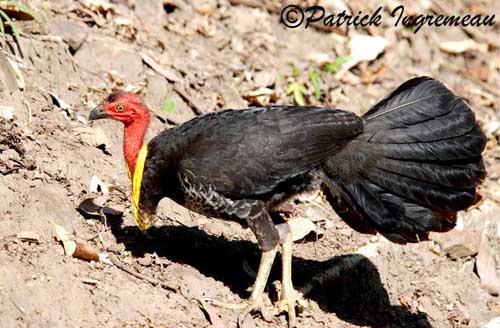
TO BE CONTINUED... Page 8
Text by Nicole Bouglouan
Photographers:
Roger Ahlman
Pbase Galleries Peru and Ecuador & My bird pictures on IBC
John Anderson
John Anderson Photo Galleries
Marc Chrétien
MURINUS
Alfredo Colón
Puerto Rico Wildlife
Tom Grey
Tom Grey's Bird Pictures
Patrick Ingremeau
TAMANDUA
Tom Merigan
Tom Merigan’s Photo Galleries
Jean Michel Peers
JMPN PHOTOGRAPHIE
Otto Plantema
Trips around the world
Dubi Shapiro
Dubi Shapiro Photo Galleries & Dubi Shapiro's Pictures on IBC
Ingo Waschkies
Bird Photography
These images and the text are subject to copyright and cannot be used without express authorization from the owners. Legal issues
Sources :
HANDBOOK OF THE BIRDS OF THE WORLD Vol 2 by Josep del Hoyo-Andrew Elliot-Jordi Sargatal - Lynx Edicions - ISBN: 8487334156
L’ENCYCLOPEDIE MONDIALE DES OISEAUX - Dr Christopher M. Perrins - BORDAS - ISBN: 2040185607
Wikipedia, the free encyclopaedia
Bird nests: Variety is Key for the world’s avian Architects
Be on the lookout for bird nests
The design and function of birds' nests
The bird and its nest, where everything starts…
Page 7: Megapodiidae, Cracidae, Tetraonidae, Odontophoridae, Phasianidae and Numididae Opisthocomidae
At the beginning of the breeding season and following several courtship displays, the nest-site is selected by the pair, or one of the members of the pair, and the nest is built within this area. For numerous species, the nest is the place where displays and copulation occur. It plays a very important role during the nesting period. It is the cradle of the chicks, the place where the adults feed them prior to their first flight towards independence.
The Order Galliformes includes ground-feeding birds with chicken-like appearance. They have heavy bodies and short, rounded wings allowing them only short-distance flights. They are often terrestrial and/or arboreal species. They usually walk or run instead of fly, and frequent several habitat types such as forests, grasslands and deserts. They nest on the ground hidden among the vegetation, in burrows or mounds, or in trees.
But the Megapodiidae are distinctive. Their nesting behaviour is very special, because the adults do not brood or incubate their eggs and have a unique incubation system.
We can find five different systems such as mound-building, burrow-nesting and using geothermal sites or burrow-nesting in solar-heated beaches, also burrow-nesting and using decaying tree-roots, and mound parasitism.
The Australian Brush Turkey builds a mound in dense vegetated area. The male builds a mound on the ground with decaying leaf matter and earth, and it adds or removes some materials in order to keep it at constant temperature of 33°C.
This mound can be very large, with two to four metres in diameter, and one metre in high.
The male builds it by scratching up the earth and plant matter with its powerful feet. The mound is re-used each year by dominant male in the best locality. Some males may have several mounds, but usually, one male has single mound.
Male and female meet briefly at mounds, and copulation occurs. Female visits and lays eggs in mounds of several males. She does not provide any parental care after laying.

In the Orange-footed Scrubfowl both adults build a mound with leaves, earth, sticks, debris, sand…circular or elongated. This mound is usually built on flat or slightly sloping ground, in shade. It can be used separately by different pairs, and it is reused year after year.
The birds do not incubate themselves. The eggs are incubated by the heat produced by the decomposition of materials. Maintenance of the mound takes place throughout the year. It can become very large, up to 3 to 4 metres of height and 9 to 13 metres in diameter or length. It can weight several tonnes.
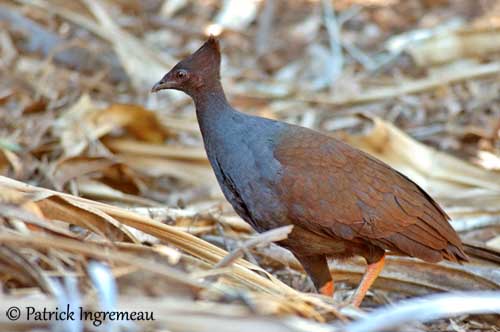
The Maleo lays the eggs at communal laying grounds, usually on solar-heated beaches and sandy soils, where the ground is heated by geothermal activity.
The burrow is mainly dug by the male and can reach up to three metres in wide and one metre in depth. The male digs with its strong feet, and finally, both sexes join forces to prepare this strange nest.
Once the burrow is dug and ready, the female enters and disappears into the burrow where she lays her eggs, usually 8-12 creamy-white eggs, typically between 20 and 60 centimetres below the surface. Then, the pair fills the burrow with sand and goes away from the site. The incubation lasts 60-80 days, and hatching occurs without any parental help.
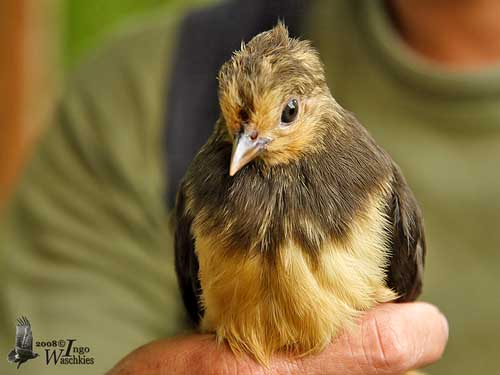
Chick
The Vanuatu Scrubfowl lays the eggs within a burrow dug between decaying roots and around rooting trees, or in volcanically-heated areas and decomposing vegetation.
On Banks Islands, the species is probably mound-builder.
Several females lay in the same nest. The burrow is 30-200 cm deep and up to 200 cm long. Between 20 and 100 eggs may be laid per burrow by several females.
The incubation is fairly long and lasts about 45 days. It is made by natural sources of heat such as some sort of volcanic activity, solar energy (especially on beaches), and by the source of heat created by the decay of rooting tree roots.
Once hatched, the chick struggles up to the surface, and needs from some hours to a full day or more. It is able to completing such a journey because it is super-precocial, a very advanced stage already upon hatching.
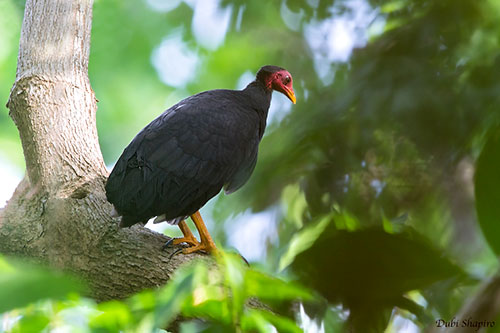
Other species, and especially the Malleefowl, use two different sources including the heat produced by the decomposition of materials, but also the heat coming from the sun’s rays.
The burrow-nesting species use natural sources of heat such as geothermal sources produced by some volcanic activity, and the solar energy. This is the case of the Megapodiidae living on islands where they have reduced suitable nesting sites. They use communal laying grounds with just some pairs to tens of thousands burrows (recorded in the Melanesian Scrubfowl in Bismarck Archipelago).
This mount-building behaviour may have evolved from the habit of covering the eggs with leaves when the adult leave the nest, in order to keep them warm and invisible. From here, the step to mount-building does not appear too difficult.
The family Cracidae is probably the most primitive family in Galliformes, and they appear to be very close to Megapodiidae through morphological similarities. Like the Megapodiidae, they are mainly restricted to the Australasian and Neotropical regions respectively. This family includes chachalacas, guans and curassows.
Cracidae species are primarily forest birds, the only arboreal family in Galliformes. However, the chachalacas are adapted for life in more open woodlands, as long as there is abundant bushy vegetation. They tend to avoid the dense forest interior.
They are usually monogamous with few exceptions. Both mates build the nest, although sometimes only male or female builds it.
The nest of the Rufous-vented Chachalaca is usually placed in tree, mainly between one and three metres above the ground, but occasionally up to 20 metres. This species may sometimes nest on the ground at grassy clearing edges. The nest is made with sticks and leaves, sometimes lined with fresh vegetation.
The Plain Chachalaca may use old nests of other species. But usually, the nest is located in a low branch of a tree, between 90 centimetres and 9 metres above the ground, among the dense vegetation. The small nest is a rather flimsy structure made with sticks, and lined with mosses and leaves.
The nest of the Chaco Chachalaca is a shallow platform. It is a loose, small structure made with sticks, stems and leaves, without any lining. The nest is often situated between 2,5 and 4 metres above the ground.
The Rufous-headed Chachalaca builds the nest in tree fork, by using sticks, twigs, grass and leaves. The nest may appear small for the bird.
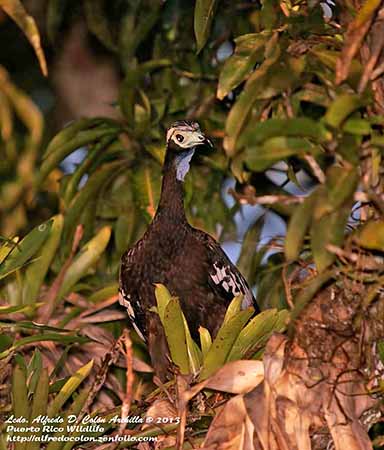
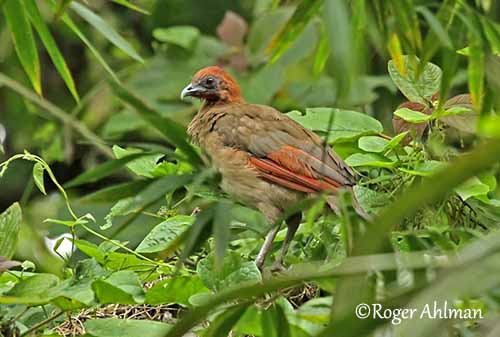
The Bare-faced Curassow builds a platform with sticks, twigs and leaves, and lined with leaves. This flat structure is placed in a tree, at about 4-5 metres above the ground. The nest is often hidden in vegetation, usually a tangle of creepers.
The Andean Guan breeds in cloud forest in mountains. The nest is a platform made with twigs and sticks, and lined with leaves. It is placed high in tree.
The Black-fronted Piping-guan builds a platform with twigs and stems in tree-fork.
The nest of the Trinidad Piping-Guan is a platform made with sticks, placed within tangle of vegetation, fairly close to the ground.
The nest of the White-winged Guan is very often placed among the vegetation, in tree or bush, at different heights. Both mates build it, at about 2 to 5 metres above the ground in the dense forest.
This structure is relatively small for this large bird. It is made with sticks, twigs, leaves and other plant materials. The inner part is often lined with fresh vegetation.
These nests are usually flat and small compared to the bird’s size. They are loosely built with sticks, twigs, creepers and other materials. The cup may be sometimes lined with fresh vegetation. The chicks are large and robust and hatching is very rapid.
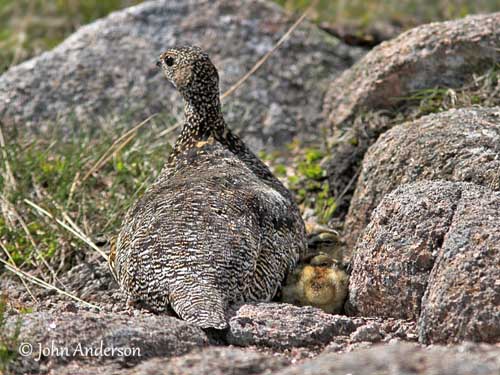
The Tetraonidae are a natural and fairly homogeneous group within the order Galliformes, and is sometimes regarded as a subfamily within the Phasianidae.
But, in spite of several morphological and behavioural characteristics shared with the Phasianidae, the Tetraonidae species show some differences such as feathered nostrils and tarsi, lack of spur, toes with scales on the sides adapted to climbing branches and walking on snow, shorter tail and heavier body with duller plumage.
The female selects the nest-site. The nest is usually situated on the ground, but some species such as the Western Capercaillie and the Hazel Grouse may occasionally use old abandoned nests some metres above the ground.
The nest is well hidden among the thick vegetation, and even partially covered in species living in open areas. Others are close to tree-trunk or stones in forest species.
However, such locations provide some visibility to the incubating female.
The nest is a shallow depression with basic lining such as blades of grass, dry leaves, twigs and sometimes feathers.
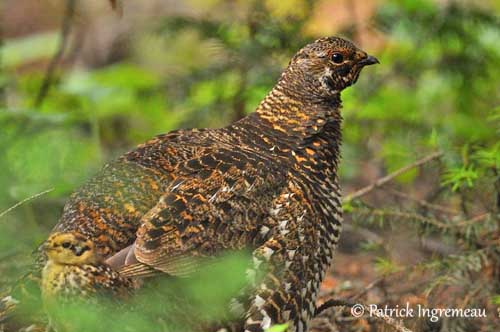
Female with chick
The nesting duties are assumed by the female alone. She leads her brood to areas where the food is abundant. They feed on insects during the first few days. If she gives alarm calls, the brood disperse with chicks running in all directions to hide. She protects them from the climate too, and covers them with her wings to keep them warm.
The chicks grow rapidly and wander farther from their mother while foraging. The family group breaks out when they are three months old.
Female and chick
The family Odontophoridae includes the New World quails found in the Neotropical Region and in the southern part of the Nearctic Region. Their appearance is very similar to that of the Old World quails and partridges. Their short, powerful legs indicate mostly terrestrial habits, although they are able to fly short-distances, but they prefer to run rather than fly. They live in a variety of habitats ranging from tropical rain forests to desert scrub. They are gregarious birds and often live in groups.
The New World quails usually nest on the ground, in a simple shallow depression lined with vegetation. This structure is often hidden from above by thick vegetation, but some species may build a dome-shaped nest with long tunnel entrance.
The California Quail breeds in shrubby areas and open woodlands. The nest is usually protected by shrub, tussock or other cover.
The nest of the Gambel’s Quail is placed on the ground, a shallow depression concealed among the vegetation and lined with grasses, stems and feathers.

Pair
The Northern Bobwhite nests on the ground in a shallow depression lined with grass and dead vegetation. The nest is often covered and hidden by a woven arch made with the standing vegetation around the nest, and we can see a small side entrance.
The chicks are nidifugous and wander off from the nest soon after hatching. They are guarded by the female or both adults in a family group.
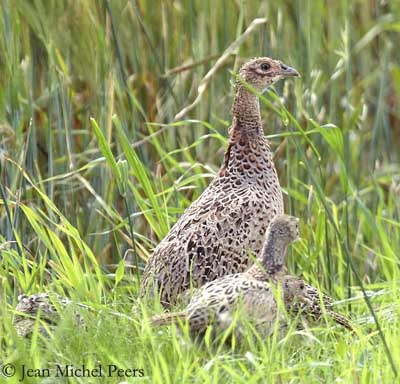
The family Phasianidae is the largest of the order Galliformes. It includes pheasants, partridges and their allies. They are small to large terrestrial birds. The Perdicinae frequent every terrestrial ecotype, except from tundra and boreal forest where Tetraonidae are living. The Phasianinae occur from the lowlands up to high alpine meadows, and the families occupy mountain slopes throughout the wide range in both temperate and tropical areas.
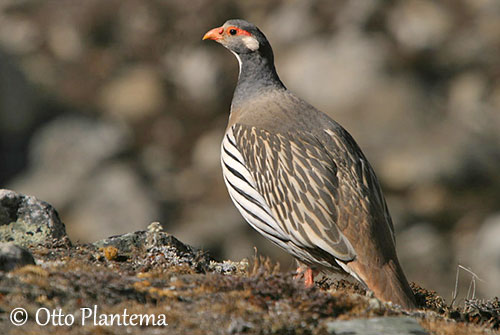
Following the courtship displays and the copulation, the female alone or both mates search for the nest-site. The nest is often on the ground. Only the Tragopans nest up to several metres above the ground, in trees or bushes.
The nest is often situated at base of clump of grass or bushes, or sheltered by rocks. It is a simple scrape in the ground, sometimes lined with dry vegetation such as leaves and roots. But the lining depends on local conditions. Some materials such as twigs are sometimes added, but rarely.
Female with young
The chicks are precocial and able to move and to feed as soon as they hatch. The adults lead them to food sources and the young feed on their own. But the female, or both parents, may also help the young by tossing food towards them, or placing it in front of the chicks, or even sometimes from bill to bill. The adults call to indicate the food items to the young.
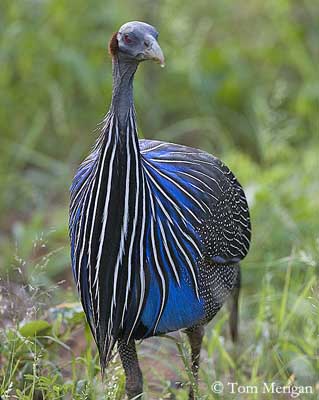
The family Numididae is endemic to Africa. The guineafowls constitute a distinctive group within the order Galliformes, but their structure and morphology are rather similar to other members of this order.
They occupy almost all available habitats types, from the dense rain forest to arid steppes and semi-desert, and they can be found at high elevation. They are terrestrial and rarely fly. They are gregarious except during the breeding season.
Only some nests have been found, but these birds usually lay their eggs in a shallow depression in the ground. It is placed at base of tree or in tall grass. It is sometimes lined with some dry leaves or little grass.
The Vulturine Guineafowl nests on the ground, in a scrape made by the female. The nest is situated under the cover of dense tussocks of grasses, or protected by rock or bush. It breeds in dry, open areas with some trees and bushes in savannahs or grasslands.
The chicks are precocial and leave the nest almost immediately. They are able to feed themselves but their parents protect them for some time. They are able to fly about 15-20 days after hatching, and can reach the communal roosts in trees.
Order Opisthocomiformes
The Hoatzin, after several passages thought several Orders such as Galliformes and Coliiformes, has also been classified in the Cuculiformes from which it differs by typical, non-zygodactyls toes.
Other sources IOC World Bird Names place this species in its own order Opisthocomiformes, and its own family, Opisthocomidae of which it is the unique member. Actually, any bird species appears closely related to this bird.
This is a colourful bird, with frizzy crest and long tail. We can say it has a “prehistoric” appearance with particular “wing claws” similar to those present on the wings of the first known lizard-bird, the Archaeopteryx.
It lives in flooded forests along streams, mangroves, swamps.
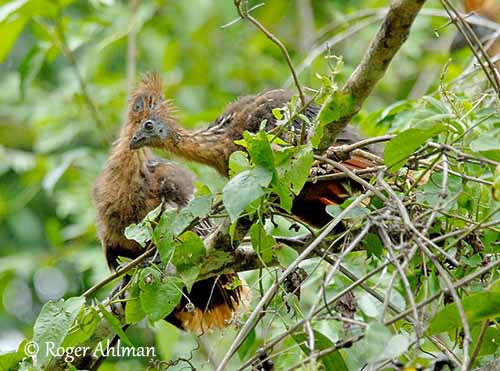
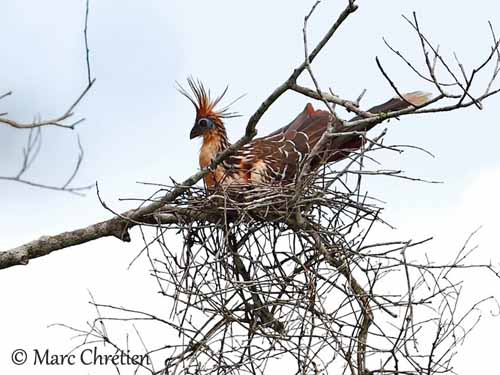
The nest of the Hoatzin is located in a tree, above water. It is a loose platform made with sticks and dry twigs, at about 2 to 8 metres above water. They breed in community, and 2 to 6 adults may cooperate for building the nest and helping breeding pair.
The chicks are semi-precocial and leave the nest at about two to three weeks of age, but they are able to jump out into the water, and swim with wings and feet, in order to escape predators at nest.
Chicks